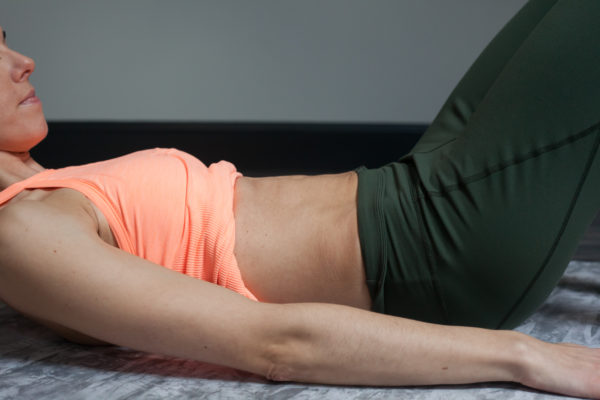Diastasis rectus abdominis (DRA), the fancy name for an abdominal split is often associated with pregnancy and the postpartum period. Although it sounds daunting, DRA can occur from as early as 14 weeks pregnant and will affect 100% of pregnant women by the time of birth, so it is a completely normal condition! About half of these will resolve themselves within 8 weeks postpartum, however the other half will remain as they are and require intervention to fully resolve.
Previously we thought the DRA was all about the “gap”. Research has progressed greatly in the past few years and we now know so much more to rehabilitating a DRA.
What exactly is DRA?
DRA is the separation of the abdominal muscles due to increased laxity of the abdominal wall and relates to the stretching and thinning of the linea alba (the tissue that runs down the front of your body). Primarily seen in pregnancy but this can also occur to those who regularly lift heavy weights, have experienced major weight loss, hormonal changes such as the menopause or HRT, or midline abdominal surgery.
Why is it important?
Your abdominal muscles are important for all bending movements of your trunk, side bending and rotating. The support your internal organs and provide much stability when you cough, sneeze. laugh, toilet, or give birth. The core/abdominal region is also responsible for transferring the load through your body when you move, lift, or exert force with the arms or legs.
If you have a DRA, you will naturally have less strength and stability in the front of your abdominal wall, therefore providing less support to all of the above activities. Over time, this could lead to low back pain, pelvic pain, and a number of other musculoskeletal problems as a result of poor core/abdominal support to transfer the load through.
It was previously thought that the extent of a DRA was based on how big the gap was between the two parts of the abdominal muscles. Now however, we know so much more about the function of the abdominals and the linea alba that knits them together and we know that the depth, severity of width, integrity of the line alba and tension created within the muscles must all be considered.
E.g. you can have a wide gap/split but still produce good tensile strength; or you can have a small gap but lack in this tensile strength. Ultimately the strength is essential to rehabilitation as this is what will support you internally and across all your trunk movements. Of course, minimising the gap and depth of softness will also be beneficial to ensure full support at your front.
How to rehab your DRA
Like everything, there are several different ways suggested for rehabilitation. As we discussed above, the importance of strengthening your abdominals, not only to minimise the gap, but to provide tension through the muscles so that they can withstand forces applied during daily life is the key factor in repairing your DRA. Other options such as massage, tape, acupuncture, even surgery etc, may help initially, but ultimately the only way to strengthen this gap and resolve the issues is to exercise it.
Muscle activation of the transverses abdominis (widely known as your main “core” muscle), followed by rectus abdominis (the “6-pack” muscles) has been shown to be the preferential way to provide load to the linea alba correctly. This ensures the gap is not further widened or the linea alba distorted incorrectly.
These exercises should be completed in crook lying initially to ensure accurate engagement of the correct muscles, and to minimise compensations. Read more about exercising after a C-section here.
Compensations may include:
- Poor posture eg. forward head posture
- Rib flaring (ribs lifting upwards during abdominal exercise)
- Lower back arching
- Chest tightening or tensing of the upper shoulders/neck
- Altered breathing patterns
Correct breathing patterns encourage natural and more efficient recruitment of the core muscles during exhalation; whereas inhaling during recruitment can cause abdominal bracing and inefficient muscle activation. Breathing patterns should be taught properly to utilise this because the diaphragm, core, and pelvic floor work together to control the pressure within the abdomen and this is a key factor in optimising core muscle recruitment.

Photo 1: Showing the doming/bulging of the abdominals during a loading exercise. Note how the stomachs full and bulging and the lower back has arched from the floor.

Photo 2: Showing the abdominals during a loaded exercise with pre-activation of the transverses abdominis first. Here the abdominals are engaged, NOT doming or bulging and the spine remains in neutral.
Applying load to the abdominals
Once correct transverses abdominis (core) muscle recruitment is established with no compensations, these exercises should be loaded. Applying load is one of the strongest stimuli to cause adaptation to tissues and stimulate tissue healing. Load should be applied on the mat via various methods:
- Raising a limb off the ground
- Moving a limb away from the trunk
- Adding a resistance band/weight/resistance circle
- Creating an unstable surface such as with the soft ball
Load should then be taken up in to functional movements and standing positions. This allows the abdominal muscles to develop tension and strength in the positions they will be required to adapt to, with the force required.
Load prescription is currently best described as the maximum abdominal loading without compensations ie. choose the hardest exercise you can complete without compensation and complete as many repetitions until fatigue. This is hard to prescribe generally so it is best to seek advice from a physiotherapist.
OR- For a very specific guide coming your way soon- send me your email address using the contact form on this website to get your copy first! This guide is specifically tailored to rehabilitating your core, including DRA and has very specific loading progressions throughout with full guidance and tips!




